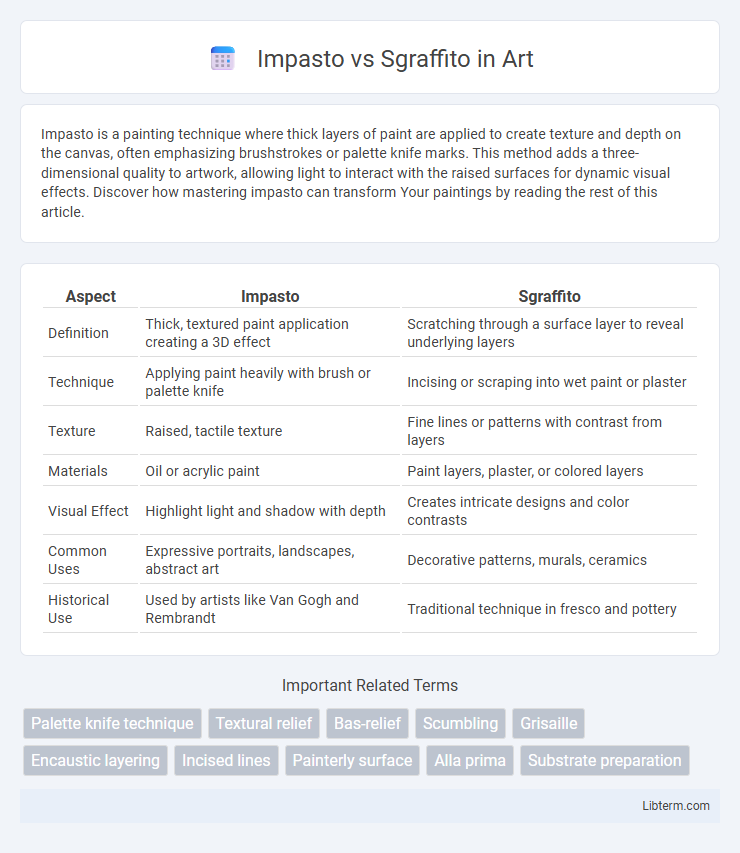Impasto is a painting technique where thick layers of paint are applied to create texture and depth on the canvas, often emphasizing brushstrokes or palette knife marks. This method adds a three-dimensional quality to artwork, allowing light to interact with the raised surfaces for dynamic visual effects. Discover how mastering impasto can transform Your paintings by reading the rest of this article.
Table of Comparison
| Aspect | Impasto | Sgraffito |
|---|---|---|
| Definition | Thick, textured paint application creating a 3D effect | Scratching through a surface layer to reveal underlying layers |
| Technique | Applying paint heavily with brush or palette knife | Incising or scraping into wet paint or plaster |
| Texture | Raised, tactile texture | Fine lines or patterns with contrast from layers |
| Materials | Oil or acrylic paint | Paint layers, plaster, or colored layers |
| Visual Effect | Highlight light and shadow with depth | Creates intricate designs and color contrasts |
| Common Uses | Expressive portraits, landscapes, abstract art | Decorative patterns, murals, ceramics |
| Historical Use | Used by artists like Van Gogh and Rembrandt | Traditional technique in fresco and pottery |
Introduction to Impasto and Sgraffito
Impasto is a painting technique where thick layers of paint are applied to create texture and depth, allowing brush or palette knife strokes to remain visible, enhancing the three-dimensional effect. Sgraffito involves scratching through a surface layer of paint to reveal the layer beneath, producing intricate patterns and contrasting textures. Both techniques are popular in acrylic and oil painting for adding visual interest and tactile quality to artwork.
Defining Impasto: Technique and Materials
Impasto is a painting technique characterized by thick, textured layers of paint applied with a brush or palette knife, creating a three-dimensional effect on the canvas. Artists typically use heavy-bodied oil or acrylic paints mixed with mediums like gel or modeling paste to achieve the dense, sculptural texture. This method emphasizes brushstrokes and surface texture, allowing light to catch the raised paint and enhance the visual depth of the artwork.
Explaining Sgraffito: Method and Tools
Sgraffito is an artistic technique involving scratching through a surface layer to reveal a contrasting color or texture beneath, commonly used in pottery, painting, and wall decoration. The method requires tools such as palette knives, needles, or specialized sgraffito tools to carefully carve intricate designs into layers of plaster, paint, or slip. This approach emphasizes texture and depth, allowing artists to create detailed patterns and vivid contrasts by exposing the underlying material.
Historical Origins of Impasto and Sgraffito
Impasto traces its origins to the Renaissance period, where artists like Titian employed thick layers of oil paint to create texture and enhance light effects. Sgraffito, deriving from the Italian word "sgraffiare" meaning "to scratch," dates back to ancient pottery techniques and was later adapted in fresco painting during the Renaissance for decorative and narrative purposes. Both techniques evolved through centuries to serve as expressive tools in painting and decorative arts.
Key Differences Between Impasto and Sgraffito
Impasto involves applying thick layers of paint to create texture and dimensionality, allowing brushstrokes and palette knife marks to be visibly pronounced. Sgraffito, in contrast, is a technique where layers of paint or plaster are scratched away to reveal underlying colors or surfaces, emphasizing line work and contrast. The key difference lies in impasto's additive process building up texture, while sgraffito employs a subtractive method to expose layers beneath.
Artistic Effects: Texture and Visual Impact
Impasto technique creates bold, textured surfaces with thick layers of paint that add dimensionality and dynamic light reflection to artwork. Sgraffito involves scratching through a top layer of paint or plaster to reveal underlying colors, producing intricate patterns and a tactile, engraved appearance. Both techniques enhance visual impact by emphasizing texture--impasto with raised, palpable ridges and sgraffito through detailed, recessed designs.
Best Surfaces for Impasto vs Sgraffito
Impasto techniques achieve the best results on rigid, non-absorbent surfaces such as primed canvas, wood panels, or Masonite to support thick, textured paint layers without cracking. Sgraffito requires a smooth, matte surface like gessoed boards or paper with acrylic ground to allow precise scraping through dried paint layers for intricate texture and detail. Both methods benefit from stable, well-prepared surfaces that prevent warping and optimize paint adhesion.
Notable Artists and Signature Works
Impasto technique, characterized by thick, textured paint application, was famously employed by Vincent van Gogh in works like "Starry Night," showcasing expressive brushstrokes and vibrant color. Sgraffito, involving scratching through a top layer to reveal underlying paint, is notably seen in Pablo Picasso's ceramic work and artists like Jean Dubuffet, who used it to add dynamic texture and contrast. Both techniques highlight distinctive artistic expressions, with impasto emphasizing dimensionality and sgraffito focusing on intricate surface patterns.
Choosing the Right Technique for Your Art
Impasto technique creates texture through thick, layered paint that adds dimensionality and expressive brushstrokes, ideal for artists aiming to emphasize volume and tactile effects. Sgraffito involves scratching through a top layer of paint to reveal underlying colors, perfect for detailed line work and surface contrasts that enhance narrative depth. Selecting between impasto and sgraffito depends on whether your composition benefits more from bold texture or intricate surface patterns, aligning your artistic intent with the tactile and visual impact desired.
Tips for Beginners: Success with Impasto and Sgraffito
Mastering impasto requires using thick paint application with palette knives or stiff brushes to create texture and dimension on the canvas, while sgraffito involves scratching through a wet layer to reveal underlying colors or surfaces. Beginners should practice controlled layering and experiment with different tools, such as palette knives for impasto and fine-tipped sticks or needles for sgraffito, to achieve varied effects. Maintaining a balance between paint thickness and drying time is crucial for success in both techniques, ensuring clear, defined textures and vibrant contrasts.
Impasto Infographic

 libterm.com
libterm.com